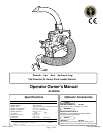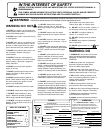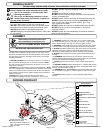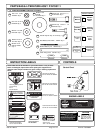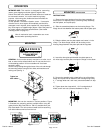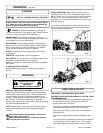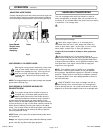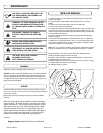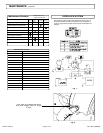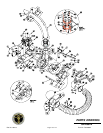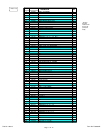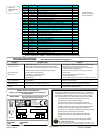
Part No. 790161 Form No. F032399A
Page 7 of 12
OPERATION continued
HANDLING & TRANSPORTING
NOTE: Fuel stabilizer (such as Sta-Bil) is an acceptable
alternative in minimizing the formation of fuel gum deposits
during storage. Add stabilizer to gasoline in fuel tank or storage
container. Always follow mix ratio found on stabilizer container.
Run engine at least 10 min. after adding stabilizer to allow it to
reach the carburetor.
Never store engine indoors or in enclosed poorly
ventilated areas with fuel in tank, where fuel fumes may
reach an open flame, spark or pilot light, as on a furnace,
water heater, clothes dryer or other gas appliance.
If engine is to be unused for 30 days or more, prepare as
follows:
Be sure engine is cool. Do not smoke. Remove all
gasoline from carburetor and fuel tank to prevent gum deposits
from forming on these parts and causing possible malfunction
of engine. Drain fuel outdoors, into an approved container, away
from open flame. Run engine until fuel tank is empty and
engine runs out of gasoline.
STORAGE
Drain all fuel prior to storage.
The unit is equipped with small front wheels to allow for
easier transportation to storage. With unit removed from its
mounting, tilt unit forward toward the ground and use wheels
to manuever it into storage area.
HOSE STORAGE: Store hose as straight and flat as
possible. Storing hose in a covered area, out of sunlight and
heat will prolong hose life. Do not store hose where it could be
stepped on or where other objects could crush or damage hose.
UNCLOGGING A CLOGGED HOSE:
With engine running and unit secured to a trailer, truck
bed, or other similar surface, fully stretch hose in a
straight line to dislodge the clog. If the clog will not
clear, turn unit off, and allow engine to come to a
complete stop. Remove hose and manually clear
hose clog.
NOTE:
The clogged debris may be sharp. Always wear durable
gloves when removing clog.
UNCLOGGING A CLOGGED HOUSING OR
EXHAUST ELBOW:
Turn engine off and wait for impeller to come to a
complete stop. Disconnect spark plug wires and
battery cables. Remove the hose coupler from the
housing and determine where the clog is located. If
possible clear the clog through the intake opening. It may
require removal of the intake adaptor (item 33) to allow access
to clear the housing. If clog is in the elbow, carefully remove the
elbow. Remove elbow by removing the knobs on the elbow
clamp. Then remove 3 bolts so that the split plate can be taken
out. FInally, the elbow can be removed by sliding it past the
remaining attached clamp.
NOTE:
Elbow is very heavy. Do not stand directly under elbow
during removal.
Danger, the clog may contain sharp materials. Wearing durable
gloves, clear the clog. Reconnect spark plug wire.
Fig. 5
Hose Bands.
Stretch hose
out before
clamping.
Hose
ADJUSTING HOSE BOOM:
Properly adjusting the boom will prevent most hose clogs from
occurring and will maximize vacuum performance by keeping
the hose straight and perpendicular to the housing (see fig. 5).



